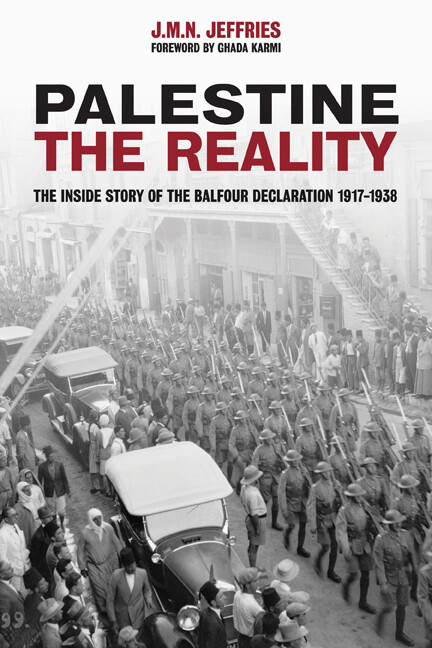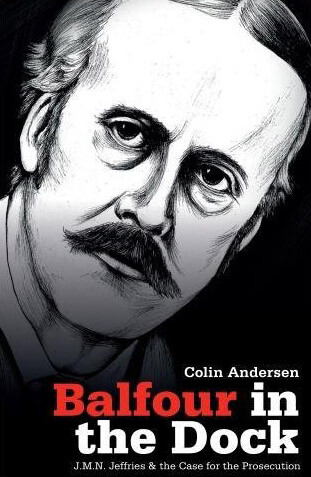
Palestine the Reality: The Inside Story of the Balfour Declaration 1917-1938 by J.M.N. Jeffries, Olive Branch Press and Skyscraper Publications (2017)
Balfour in the Dock: J.M.N. Jeffries and the Case for the Prosecution by Colin Andersen, Skyscraper (2017)
Few people, even those dedicated to Palestinian history and politics, are familiar with the name of Joseph Mary Nagle Jeffries (1880-1960). One reason is the bombing of a publishing house in London during the German blitz of 1940. The fire that ensued destroyed most of the copies of his 750-page magnum opus Palestine: The Reality, and prior to its recent publication by Skyscraper only 20 copies could be traced in the world.
The book’s curious publication history is narrated by Andy Simons in his preface to the new edition of Palestine: The Reality. It is also described in Colin Andersen’s work Balfour in the Dock.
A summary of what is known of J.M.N. Jeffries’ life is found in Ghada Karmi’s fine introduction to the recent edition of Palestine: The Reality. He was born to an Irish family, never married, and was “chiefly known as a major war correspondent for The Daily Mail, reporting on the First World War from 1914-1918 during which time he set a record by sending dispatches from 17 countries, including Egypt, Albania and Russia.”
Palestine: The Reality was Jeffries’ third significant book and was the culmination of 12 years’ work. On publication, it was frequently compared to George Antonius’ seminal book The Arab Awakening (1938).
However, by the outbreak of war in 1939, Jeffries had stopped working for The Daily Mail and disappeared into “unemployment,” according to one source. He resurfaced in Madrid, working in the British embassy’s press office. Little is known of his life in Spain, where he remained until his death, or if he continued following the Palestine issue from there.
It is known, though, that Jeffries tried and was unable to republish Palestine: The Reality.
Weighty critique
Of the two works reviewed here, Jeffries’ book can be regarded more as primary source material, a collation of historical documents, debates and dispatches from Palestine, meticulously constructed to present a weighty critique of the Balfour Declaration and its legacy. Covering the period 1917 to 1938, it is an invaluable resource for researchers of the period, providing a wealth of detail, a cogently positioned argument that is alive with vivid imagery and wit.
Andersen’s work Balfour in the Dock, in contrast to Palestine: The Reality, is an accessible, contemporary work. It makes a case not just for the prosecution of Arthur James Balfour, the British foreign secretary who supported Zionist colonization in Palestine, but for the defense of Jeffries.
Andersen retaliates against all the jibes and criticisms leveled at Jeffries that sought to discredit him either for his approach, perceived bias, or the reliability of his content. Focused on the Palestine experience in Jeffries’ life, the book also provides mini-biographies of personalities from that period. It is an engaging work.
These two books show that both Jeffries’ lively and nuanced writing style, and his nose for an angle and eye for detail, have survived the test of time.
As a journalist, Jeffries had a clear-eyed vision of the realities he saw, stripped clean of the racial and class prejudices prevalent at the time. This made him able to predict better the potential outcome of the situation he experienced than many others whose role in the region was overblown at best and misguided at worst, such as diplomat and writer T.E. Lawrence.
Andersen skilfully juxtaposes Jeffries’ and Lawrence’s analyses of the outcome of Zionism on the region, showing how Lawrence was fundamentally lacking in comprehension of the nature of the Zionist project and the concept of expulsion that underlay its core beliefs. “The success of their scheme will involve inevitably the raising of the present Arab population to their own [the Jewish immigrants’] material level,” Lawrence wrote cheerfully in 1920.
“Fraudulent” pledge

Palestine: the Reality and Balfour in the Dock both have the Balfour Declaration at their core. Both were published during 2017, the year of the declaration’s centenary and amid all the duplicitous pomp and circumstance that has surrounded that event in the UK.
The declaration was described by Jeffries as “an extremely confused document.” It did not enjoy universal support from the British government and was opposed by the only Jewish cabinet minister at the time, Edwin Montagu.
It is now forgotten that at the time of the declaration in 1917, Palestinians constituted around 91 percent of the population of Palestine, but in Balfour’s declaration were relegated the status of “the non-Jewish communities of Palestine,” a wording Jeffries condemned as “fraudulent” and designed merely “to conceal the true ration between Arabs and Jews, and thereby to make easier the supersession of the former.”
What riled Jeffries and others with his vision, is that for the Zionist project to succeed the Palestinian population could not be seen, and if it was to be seen, it could only be seen as a mess to be cleared away. The founder of Zionism, Theodor Herzl, believed Palestine could be a better option than Argentina for colonization if it could be presented as an “outpost to civilization as opposed to barbarism.”
Andersen selects an incisive analysis by Walid Khalidi of Herzl’s diary entries from Palestine where Herzl fails to acknowledge a single Palestinian, concluding, “if Zionism was unaware of the Arabs it was because most Zionists perceived an obstacle in the Arabs and did not want to be aware of them.”
Marginalized
Jeffries was not without supporters during his time in Palestine, notably his editor at The Daily Mail, Lord Northcliffe (real name: Alfred Harmsworth), who visited Palestine in 1922 and described the country as “running the risk of becoming a second Ireland.”
Northcliffe is also quoted as stating during his visit what should have been obvious: “we mustn’t suppose that because a man wears a turban or a tarboosh that he is a fool or slow or unable to combine.” It was an approach Balfour did not appear to share. During Balfour’s visit to the region three years later, he is reported to have “insolently” inquired on seeing the Arabs of Jerusalem, “Who are those men in petticoats?”
Northcliffe died shortly after his visit to Palestine, a critical loss for Palestinians seeking supporters in the British press as Northcliffe’s editorial attacks on the Balfour Declaration would have gained more weight had they also spread to The Times, of which he was a part owner.
In his 1939 review of Palestine: The Reality, the writer Nevill Barbour wrote that Jeffries “set out, in the same sort of crusading spirit in which Emile Zola once set out to investigate the Dreyfus case, to expose what he considered to be a grave miscarriage of justice.” That review underscores Jeffries’ perception of the role of chance in determining the future of the region.
Barbour summarizes Jeffries’ conclusions, that the Balfour Declaration was “forced through” Britain’s war cabinet by Balfour and David Lloyd George, the prime minister, in the absence of Edwin Montagu, then visiting India. Montagu, a staunch critic of Zionism, had previously “succeeded in inducing the cabinet to reject the proposal,” Barbour writes. There was, therefore, “no preliminary discussion of the project in Parliament, nor was any serious investigation made into conditions in Palestine.”
The only person with any real knowledge of the realities, according to Jeffries, was the politician and diplomat Mark Sykes, who had developed “grave doubts” about the Zionist project. Had he not died prematurely in 1919, Sykes, according to Jeffries, would have been able to “use his influence to modify the project.”
Commentary around Joseph Jeffries and his work implies that his career suffered due to his unwavering support of the Palestinian cause. Both Balfour in the Dock and the new edition of Palestine: The Reality seek to reinstate his reputation.
J.M.N. Jeffries serves as an example of what writing and journalism could and should be.
Selma Dabbagh is a British-Palestinian writer. Her debut novel, Out of It, was published by Bloomsbury (2012).
Geen opmerkingen:
Een reactie posten
Opmerking: Alleen leden van deze blog kunnen een reactie posten.